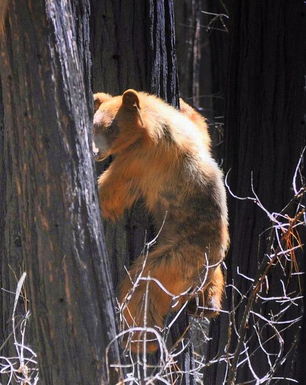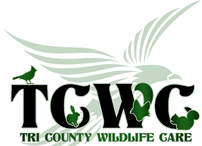January 2018 - The American Black Bear

Black bears are large! Females weigh between 100 and 200 pounds, and adult males weigh between 150-350 pounds. Some hunters in California have taken bears weighing over 600 pounds.
Black bears have a small, narrow head, very powerful limbs, and little ears. They are not always black. They will vary in color from tan/brown to black and sometimes will have a small white chest patch. The five toes with well-developed claws on all feet enable them to quickly climb trees to evade predators. Their teeth allow them to feed on both plants and animals. These great big mammals will consume little, bitty ants and other insects in summer. But they prefer nuts, acorns, and manzanita berries in autumn. Though they mostly eat plants, they will catch and consume young fawns. If natural foods are scarce, or berry and acorns yields are low, bears may grab a quick lunch from your garbage can. Body language is important to bears. If they hold their head below their shoulders, this indicates aggression. Facial and mouth expressions including snarls, salivating while opening and closing the mouth, bearing the teeth or making chomping noises indicate agitation. They will also call an intruder’s bluff by charging at full speed and stopping just short to tell the intruder in no uncertain terms to leave. Black bears hibernate, or more correctly experience seasonal lethargy, dozing for months with a body temperature as low as 88 degrees. True hibernators such as chipmunks and ground squirrels drop their body temperature below 40 degrees. Black bears large pelts keep them warm, and their large size allows them to easily retain body heat better than a small mammal. If disturbed, they can awaken but it will take a few minutes. The metabolic rate is cut in half during hibernation so their body fat provides all they need. Bears will lose between 15 and 30 percent of their body weight and reproductive sows (females) can lose to up 40 percent. Over 90 percent of bears survive the winter despite this great weight loss. The weight loss is mostly fat as they maintain their muscle mass and tone during this period. June and July is mating time for bears. An abundance of high quality food in summer and autumn ensures reproductive success. A female bear uses a strategy called “delayed implantation” by carrying a fertilized egg in her womb until her body gives some unknown signal that the time is right for the egg to attach itself to the uterine wall and begin development. Delayed implantation allows the bears to time the birth of cubs by delaying if food is scarce. If at hibernation her fat stores are insufficient, the egg will abort. Bears are able to reproduce by their fourth or fifth year and generally breed every other year producing two to four cubs per litter. The young are born in early February while the mother is still hibernating. Cubs weight less than a pound at birth and leave the den in April or May weighing five to seven pounds. Cubs learn everything from their mother about how and where to find food and avoid danger. Mother bears are good disciplinarians using growls, grunts, and a quick swat if cubs don’t pay attention. Cubs will stay with mom for up to two years before going off on their own. California Department of Fish and Wildlife considers human food and garbage to be the primary source of bear conflicts. Tri County Wildlife Care has suggestions for dealing with nuisance bears - http://www.pawspartners.org/nuisance-blackbear.html and http://www.pawspartners.org/uploads/2/3/9/3/23935372/caf_g-blackbear.pdf. Please do not put yourself in danger by leaving tempting garbage for bears. Research into the biochemical mystery of bear’s ability to create new protein from nitrogen-rich urea and metabolizing only fats could someday help humanity with dieting. A cure for degenerative arthritis and bone disease may come from studying bears ability to re-build bones during hibernation. Saving wildlife saves us! Tri County Wildlife Care, a local nonprofit started in 1994, is dedicated to the rescue and rehabilitation of our native wildlife and helping our community live in balance with wildlife. They envision a world where wildlife and people thrive together. For more information call (209) 283-3245, or visit pawspartners.org. |
Learn More!
|

